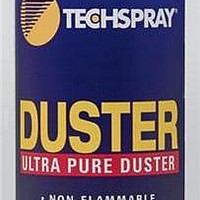1671-15S Techspray, 1671-15S Datasheet - Page 3

1671-15S
Manufacturer Part Number
1671-15S
Description
Chemicals Duster, 15oz aerosol
Manufacturer
Techspray
Type
Dusterr
Datasheet
1.1671-15S.pdf
(5 pages)
Specifications of 1671-15S
Product
Dusters
Size
15 oz
Container
Aerosol
Application
1671 duster removes microscopic contaminants, lint, dust, metallic oxide deposits and other soils
Brand/series
1671 Series, Envi-Ro-Tech™
Chemical Component
1, 1, 1, 2-Tetrafluoroethane
Dispensing Method
Aerosol
Primary Type
Cleaner
Special Features
Non-Flammable
Weight
15 Oz.
Lead Free Status / RoHS Status
Lead free / RoHS Compliant
4. FIRST AID MEASURES
5. FIRE FIGHTING MEASURES
DUSTING GAS
SIGNS AND SYMPTOMS OF OVEREXPOSURE
EYES: Immediately flush eyes with plenty of water. Get medical attention, if irritation persists.
SKIN: In case of cold burns (frostbite) caused by rapidly expanding gas or vaporizing liquids, get medical attention
promptly.
INGESTION: Ingestion is unlikely because of the physical properties and is not expected to be hazardous. Do not
induce vomiting unless instructed to do so by a physician.
INHALATION: Remove to fresh air. If not breathing, give artificial respiration or give oxygen by trained
personnel. Seek immediate medical attention.
NOTES TO PHYSICIAN: Because of the possible disturbances of cardiac rhythm, catecholamine drugs, such as
epinephrine, should be used with special caution and only in situations of emergency life support. Treatment of
overexposure should be directed at the control of symptoms and the clinical conditions.
FLASHPOINT AND METHOD: Not Applicable
FLAMMABLE LIMITS: None*
AUTOIGNITION TEMPERATURE: > 750°C (1382°F)
FLAMMABLE CLASS: Not Applicable
FLAME PROPAGATION OR BURNING RATE OF SOLIDS: Not Applicable
EXTINGUISHING MEDIA: As appropriate for combustibles in area.
EXPLOSION HAZARDS: This product is not flammable at ambient temperatures and atmospheric pressure.
EYES: Liquid contact can cause irritation, which may be severe.
SKIN: Prolonged or repeated contact can result in defatting and drying of the skin which may result in skin
irritation and dermatitis (rash).
INHALATION: High concentrations in immediate area can displace oxygen and can cause dizziness,
unconsciousness, and possibly death with longer exposure. Keep people away from such vapors without self-
contained breathing apparatus.
EYES: Can cause severe eye irritation.
SKIN: Exposure to rapidly expanding gas or vaporizing liquid may cause frostbite ("cold" burn).
INHALATION: High concentrations may lead to central nervous system effects (drowsiness, dizziness, nausea,
headaches, paralysis and loss of consciousness).
ACUTE TOXICITY: Overexposure may cause dizziness and loss of concentration. At higher levels, CNS
depression and cardiac arrhythmia may result.




